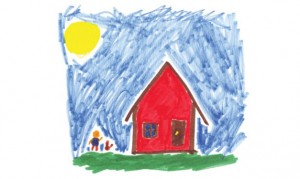According to a report conducted by the Coalition of the Homeless last month, a record high 50,000 people slept in New York City’s shelters this January. Fifty-thousand people. More people are now homeless in New York City than at any time since the Great Depression. Want to know an even scarier fact? Almost half of the individuals are children.
 Approximately 1.6 million children in the United States are now homeless, a 33% increase in the last couple years. It’s not just in New York City either. It’s in California, Nevada, Texas, and Florida too. It’s taking place across the entire country. Families with children are forced to live on the streets, in homeless shelters, and in other forms of temporary housing. They’re crammed into motels, cars, and are doubled up with other families – all simply trying to make ends meet.
Approximately 1.6 million children in the United States are now homeless, a 33% increase in the last couple years. It’s not just in New York City either. It’s in California, Nevada, Texas, and Florida too. It’s taking place across the entire country. Families with children are forced to live on the streets, in homeless shelters, and in other forms of temporary housing. They’re crammed into motels, cars, and are doubled up with other families – all simply trying to make ends meet.
Homeless families are currently one of the fastest growing segments of the homeless population in the United States, and in a large part, the economic recession is to blame. There have been budget cuts. Job losses. Foreclosures. Add in a profound lack of affordable housing, and you’ve got yourself quite the national recipe for disaster.
So what does that mean for the kids involved? How are they affected by their family’s homelessness?
- Physical Health Risks: In general, children who are experiencing homelessness are much more susceptible to experiencing health problems (both acute and chronic) than those that are housed. They have an increased risk of having asthma, respiratory infections, ear infections, gastrointestinal infections… the list goes on and on. Poor nutrition is also a key contributing factor to many of the health problems associated with child homelessness, such as stunted growth and iron deficiencies (which often leads to anemia).
- Emotional and Behavioral Health: Children who are experiencing homelessness are three times more likely to have emotional and behavioral problems than those who are housed, according to the National Center on Family Homelessness. They also have an increased risk of developing anxiety, depression, and/or aggressive behavior. However, wouldn’t anybody in their position? If your daily worries consisted not of whether or not you could go play at Johnny’s house today, but rather if you had a place to sleep that night, my guess is that anybody’s emotional and mental health would be at risk. Children who are experiencing homelessness have to worry about the possibility of being separated from their friends and family. They have to worry about what their peers will think of them in school that day. They often have to worry about their physical safety. The constant stress and anxiety weighs down on kids over time, and can often lead to long-term health consequences.
- Education: Ever try to do homework using only the lights inside your car? Or with just a flashlight because your family is not able to afford both electricity and food that month? Both narratives are highlighted in the 60 Minutes clip “The Hard Times Generation” on the current state of homelessness in America. The truth of the matter is that children who are experiencing homelessness are twice as likely to have learning disabilities (speech delays, dyslexia, etc.) and four times as likely to show delayed development as those that are housed. They’re also more like to have lower test scores, have to repeat a grade in school, and/or drop out of high school that those that are housed. When survival is at the forefront of one’s existence (and mobility is a way of life), it’s only natural that things like homework, tests, and projects will fall by the wayside.
We need to take a real close look at ourselves, and determine whether we’re really comfortable with the fact that over one million of our own children are going to bed every night with no place to call their own. It’s time we support the next generation, and provide them with a healthy environment in which to develop, learn, and grow.
The good news? According to a report published by New York City’s Coalition for the Homeless, ending homelessness for all American children is possible in the next decade if the right steps are taken. It’s about creating more affordable housing options. It’s about providing assistance to struggling renters and homeowners. It’s about phasing out the use of commercial hotels and motels as forms of temporary housing, and instead focusing our efforts on creating more permanent housing opportunities.
We can reverse this trend.
It’s about time we tried.


